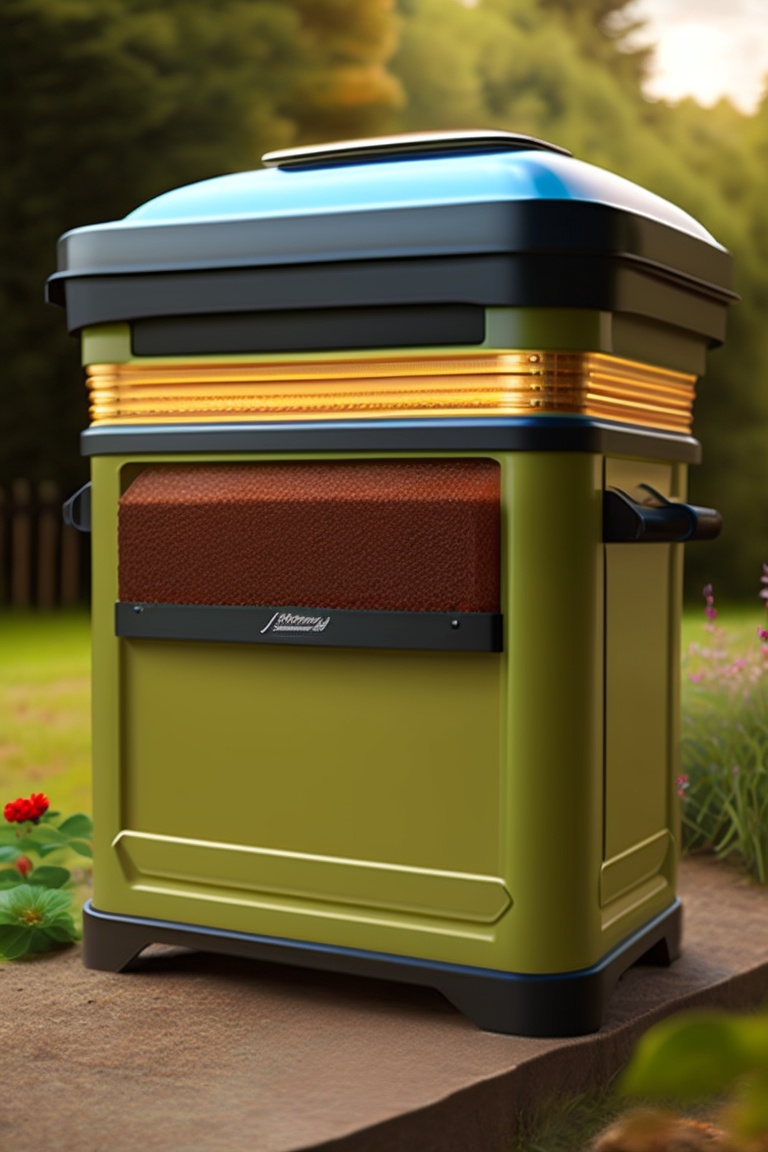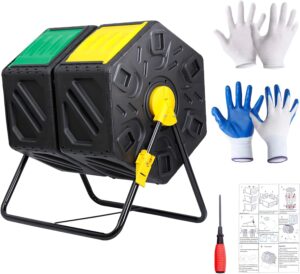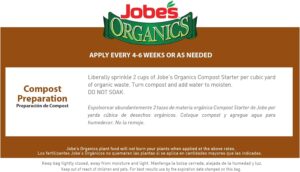Introduction to Composting: Turning Waste into Garden Gold
Welcome to the captivating world of composting, where discarded banana peels, coffee grounds, and a dash of magic transform into a gardener’s secret weapon. You might be thinking, “Why compost? Isn’t it just rotting garbage?” Well, my friend, it’s so much more. Composting is a symphony of nature, where waste harmonizes to create nutrient-rich soil that nourishes plants like nothing else. By the end of this journey, you’ll not only appreciate composting’s wonders but also have the knowledge to build your very own DIY compost bin.
Why Composting?
“Why do I compost?” you might ask. Let me share a personal tale. A few years ago, I embarked on a journey to grow my vegetable garden. Armed with seeds and enthusiasm, I soon realized I needed nutrient-rich soil for my green army to thrive. That’s when I discovered the magic of composting. By converting kitchen scraps, yard waste, and other organic materials into compost, I could create a natural fertilizer that would provide my plants with the ideal nutrition they needed to flourish.
But composting’s impact extends beyond my garden. It has a profound positive effect on the environment. When organic waste ends up in landfills, it decomposes without access to oxygen, producing methane, a potent greenhouse gas. By diverting this waste to our compost bins, we play a vital role in reducing methane emissions and combating climate change. It’s akin to turning waste into a superhero, championing a greener and more sustainable planet for all.
What Can and Can’t Be Composted: Unveiling the Recipe for Success
Composting is akin to following a delicate recipe; it requires the right ingredients for a successful outcome. So, what exactly can you toss into your compost pile? Join me on a journey through my composting adventures, where we explore the “compost me” and “no-no” categories, discovering the secrets of this eco-friendly practice.
In the “compost me” category, you’ll find a treasure trove of materials ready to be transformed into nutrient-rich compost. Fruit and vegetable scraps, the remnants of your daily culinary adventures, are top contenders. Coffee grounds and used tea leaves, after serving their caffeinated purpose, also find a new calling in the compost bin. Eggshells, often discarded without a second thought, provide valuable calcium to the mix. Yard trimmings, like grass clippings and pruned branches, introduce a wealth of organic matter.
But here’s a surprise entry into the “compost me” list – pet fur. Yes, you heard it right! Even your furry friends can contribute to the composting mix. Instead of watching your cat’s shedding season go to waste, collect that fur and let it become a part of your compost bin. It’s like a little piece of your beloved feline companion helping your garden grow.
Now, let’s turn our attention to the “no-no” items – those that should never find their way into your compost bin. Meat and fish, dairy products, and oily foods fall into this category. These materials can attract unwanted visitors to your compost pile and create unpleasant odors reminiscent of a long-forgotten gym locker. Additionally, diseased plants should be kept out of the compost, as the pathogens can survive the composting process and potentially harm your garden.
To maintain a compost bin that exudes harmony and pleasant earthy scents, stick to plant-based materials in the “compost me” category. By doing so, you’ll master the art of composting and create a recipe for success in your journey toward sustainability.
Materials Needed for Your DIY Compost Bin
Now that you’re ready to embark on this composting adventure, let’s gather the necessary materials to set up your very own DIY compost bin.
Choosing the Right Bin
Finding the perfect compost bin is like finding your gardening soulmate. It should be just the right size, sturdy, and allow proper aeration. I recall the time I started composting and opted for a small plastic bin. Little did I know, as my enthusiasm for composting grew, so did the amount of organic waste I generated. Soon enough, I found myself struggling to fit everything into the tiny bin. It was like trying to stuff an elephant into a matchbox! Lesson learned: choose a bin that matches your composting ambitions and provides ample space for organic matter to break down.
Additional Tools and Equipment
Your DIY compost bin wouldn’t be complete without a few essential tools to make your composting journey smoother. A pitchfork or garden fork becomes your trusted companion for turning the compost, ensuring proper aeration and mixing. I remember the first time I used a pitchfork to turn my compost pile. It felt empowering, like conducting an orchestra of decomposers. And don’t forget gloves! Not only do they protect your hands, but they also give you that composting superhero feel. Donning gloves, I’d dive into the pile, knowing I was making a difference with every turn.
Step-By-Step Guide to Building Your DIY Compost Bin
Now that we have our materials ready, let’s dive into the step-by-step process of building and maintaining your very own DIY compost bin. And yes, there are anecdotes to make each step more entertaining!
Step 1: Selecting the Location
Choosing the right location for your compost bin is crucial. You want a spot that receives adequate sunlight and has good drainage. Picture this: I placed my compost bin in a shaded corner of my yard, thinking it would keep the compost cool and prevent it from drying out. However, I soon discovered that lack of sunlight hindered the decomposition process. My compost took ages to break down, and I had to move the bin to a sunnier spot to get things back on track. Lesson learned: sunshine is the compost’s best friend!
Step 2: Preparing the Bin
Now it’s time to prepare your DIY compost bin for action. Drill some holes in the sides and bottom of the bin to ensure proper aeration. These tiny vents act as windows to let the compost breathe and allow beneficial microorganisms to thrive. I remember the day I drilled those holes, feeling like a compost bin surgeon performing a life-saving operation. It’s amazing how a few small holes can make a big difference in the composting process.
Step 3: Layering Your Compost
Composting is the art of layering, like creating a beautiful painting with nature’s palette. Start with a layer of browns, such as dried leaves, shredded newspaper, or twigs. These carbon-rich materials provide the foundation of your compost, acting as a source of energy for the decomposers.
Next, add a layer of greens, such as vegetable and fruit scraps, grass clippings, or coffee grounds. These nitrogen-rich materials provide the necessary nutrients for the microorganisms to thrive. Repeat this layering process, like a culinary masterpiece, until your compost bin is filled. Remember, it’s all about balance. Too many greens can lead to a slimy mess, while too many browns can slow down decomposition. Finding that perfect balance is like discovering the secret recipe for composting success.
Step 4: Maintaining Your Compost
Composting is not a “set it and forget it” endeavor. It requires care and attention, much like tending to a garden. Every few weeks, grab your pitchfork and give the compost a good turn. This mixing action provides oxygen to the microorganisms and helps distribute the heat generated by the decomposition process.
I vividly recall turning my compost pile for the first time. It felt like a treasure hunt, uncovering the hidden wonders within. As I turned the pile, I could feel the heat and smell the earthy aroma. It was a satisfying moment, knowing that I was nurturing a living ecosystem in my own backyard.
Maintaining moisture levels is equally important. Your compost should be moist, resembling a well-wrung-out sponge. I remember the summer when a heatwave hit, and my compost pile started resembling the Sahara Desert. It became dry and lifeless, hindering the decomposition process. So, I had to grab my hose and give it a good soak, reviving the compost and bringing it back to life. Don’t underestimate the power of moisture!
Common Mistakes and How to Avoid Them
Ah, the trials and tribulations of composting! Even the most seasoned composters have their fair share of mishaps. Let me share a couple more personal stories and amusing anecdotes to highlight common mistakes and how to avoid them.
One memorable composting mishap I experienced involved a curious case of the wandering compost pile. I had set up my DIY compost bin in a corner of the yard, carefully following all the steps and layering my organic materials. However, as days turned into weeks, I noticed that my compost pile seemed to be shrinking.
It took me a moment to realize that I had unintentionally created the perfect feast for some hungry neighborhood critters. They had managed to find their way into the bin, feasting on the tasty scraps and scattering my compost all over the yard. It was like a composting buffet for the local wildlife! Lesson learned: Make sure to secure your compost bin and consider adding a lid or fencing to keep unwanted guests out.
Another comical composting blunder involved my overzealous collection of autumn leaves. Every fall, I eagerly gathered bags upon bags of fallen leaves from the neighborhood, excited to have an abundant source of carbon-rich browns for my compost. However, I may have gone a bit overboard with my leaf collection.
I piled them onto my compost bin, envisioning a beautiful mountain of compost in the making. Little did I know that the sheer volume of leaves would compact and suffocate the compost, creating a slow and sluggish decomposition process. It was like burying my compost under a leafy avalanche! Lesson learned: Moderation is key when adding leaves to your compost. Be mindful of the balance between browns and greens to keep the compost lively and thriving.
These amusing anecdotes remind us that even with the best intentions, composting can sometimes take unexpected turns. But fear not! Armed with the knowledge of common mistakes and how to avoid them, you’ll navigate the composting journey with ease.
Remember, composting is a delightful dance with nature. Embrace the learning process, enjoy the little surprises along the way, and know that your efforts are contributing to a more sustainable and vibrant world.
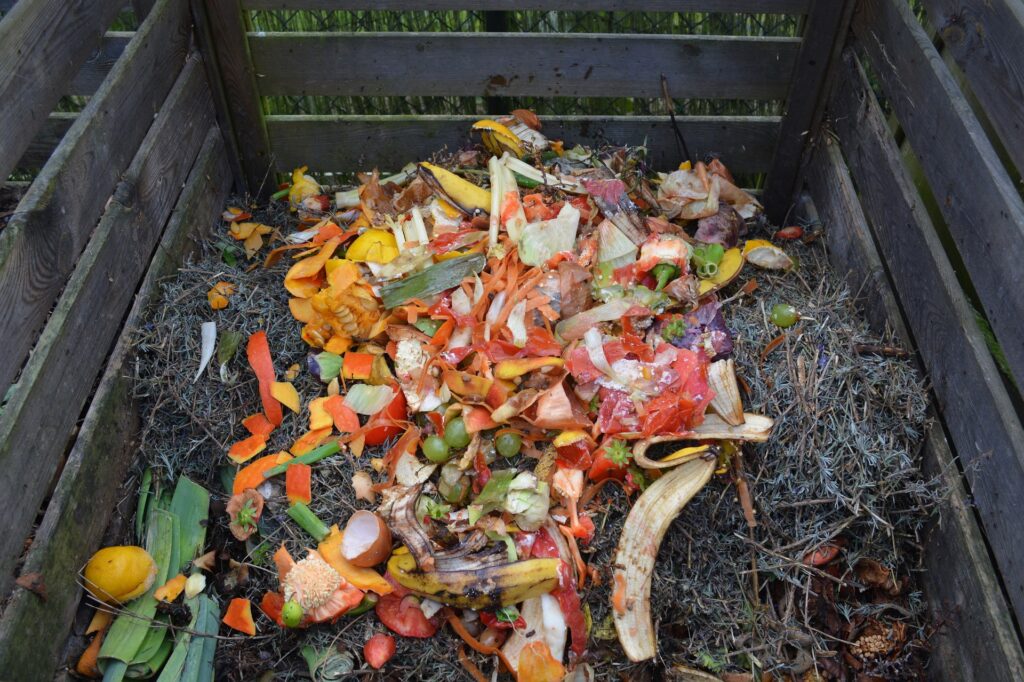
Benefits of DIY Composting: A Greener and Thriving Tomorrow
Embarking on the journey of DIY composting not only brings you closer to nature but also unlocks a myriad of benefits for the environment, your wallet, and your garden. Let’s delve deeper into these advantages to uncover the transformative power of composting.
Environmental Impact
Composting is not merely about managing your kitchen and yard waste; it’s about making a tangible difference in the environment. When organic waste ends up in landfills, it undergoes decomposition without access to oxygen, generating methane – a potent greenhouse gas. However, when you divert this waste to your compost bin, you become a climate change fighter. By doing so, you significantly reduce methane emissions and contribute to the global effort to combat climate change. It’s akin to turning waste into a superhero, with your compost pile actively working for a greener and more sustainable planet.
Economic Advantages
Composting isn’t just eco-friendly; it’s wallet-friendly too. Creating your nutrient-rich compost means you no longer need to rely on store-bought fertilizers, saving you money in the process. The utilization of kitchen and yard waste reduces household waste, and the elimination of the need for expensive soil amendments is a win-win situation for both your pocket and the planet. Composting becomes a sustainable and cost-effective way to enrich your garden’s soil naturally.
Garden Health
Your garden will thank you for embracing composting. When you introduce compost into your garden beds, you’re not merely enhancing soil fertility; you’re improving its overall structure. Compost acts as a soil conditioner, enhancing water retention and aeration, making it the ideal habitat for beneficial microorganisms. Your plants will feast on this nutrient buffet, boosting their growth, resilience, and overall health. It’s akin to treating your plants to a rejuvenating spa day, leaving them ready to thrive and reach their full potential.
Additional Resources for the Green Thumb Enthusiast
If you’re looking to further embrace sustainable gardening practices and reduce your ecological footprint, consider exploring Sustainable Supplies. This eco-conscious platform offers a diverse selection of high-quality garden tools, organic fertilizers, and other environmentally friendly gardening supplies. By sourcing your gardening needs from such eco-friendly outlets, you can align your gardening journey with your commitment to sustainability and a greener future.
Conclusion: Composting, Your Gateway to Sustainability
Congratulations! You’ve embarked on a journey to master the art of composting, and in doing so, you’ve unlocked a world of ecological, financial, and horticultural benefits. While building and maintaining a DIY compost bin might appear to be a humble endeavor, its impact is nothing short of profound.
By composting, you’re not merely managing your household waste; you’re actively participating in the global fight against climate change. Every kitchen scrap, and every yard trimming diverted from landfills, is a victory for the environment. The reduction in methane emissions, a potent greenhouse gas, is a testament to the power of individual actions in addressing the pressing issue of climate change. Composting is your gateway to becoming a superhero for a greener planet.
On the financial front, composting serves as a cost-effective alternative to store-bought fertilizers and soil amendments. You’ve harnessed the wealth hidden within your kitchen and yard waste, turning it into a valuable resource for your garden. This sustainable approach not only benefits your wallet but also supports a circular economy where waste becomes an asset.
As you embrace composting, your garden transforms into a thriving oasis of greenery. The addition of nutrient-rich compost improves soil structure, enhances water retention, and provides a buffet of essential nutrients to your beloved plants. Your garden’s health and vitality will be a testament to your commitment to sustainability.
Along this composting journey, you’ll encounter amusing stories of nature’s resilience, unexpected surprises as you witness your compost pile transform, and valuable lessons about the interconnectedness of life on our planet.
So, don your gardening gloves, grasp your pitchfork, and join the ranks of eco-conscious individuals who are composting their way to a greener and more sustainable world, one kitchen scrap at a time. Your contribution may begin humbly, but its impact reverberates far and wide, echoing the promise of a brighter, more environmentally friendly future.
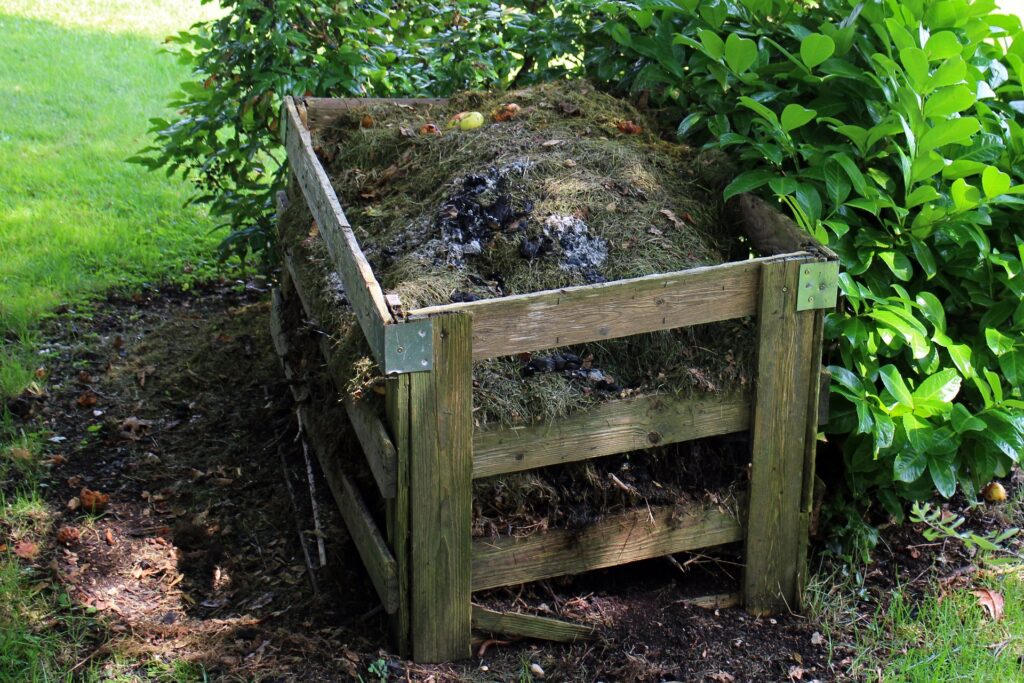
Frequently Asked Questions
What is the ideal size for a DIY compost bin? The ideal size for a DIY compost bin is typically about 3 feet in each direction. This size provides sufficient space for effective composting while remaining manageable for turning and maintenance. It strikes a balance between having enough volume to generate compost and ensuring that the pile doesn’t become too large to manage. Remember, in composting, size does matter, so aim for a bin that suits your needs.
Can I compost meat and dairy products? It’s best to avoid composting meat, fish, dairy products, oily foods, and other animal-derived materials in your compost bin. These items can introduce challenges to the composting process. They may attract pests like rodents and flies, create unpleasant odors as they decompose, and disrupt the delicate balance of your compost pile. To maintain a harmonious composting experience, it’s advisable to stick to plant-based materials that decompose more readily and without the complications associated with animal-derived products.
How often should I turn my compost pile? To maintain an effective compost pile, aim to turn it every two to three weeks. Turning the pile serves several essential purposes. It helps aerate the compost, ensuring that oxygen is evenly distributed throughout the pile. This promotes the growth of beneficial microorganisms responsible for decomposition. Additionally, turning mixes the materials, ensuring that all components receive equal attention during decomposition. Regular turning also prevents the formation of compacted layers that can impede the composting process. So, by turning your compost pile at this frequency, you provide optimal conditions for decomposition and ensure that your compost matures efficiently.
Why does my compost pile smell? A smelly compost pile is often a sign of imbalances within the composting process. Two common culprits are inadequate aeration and excessive moisture. To mitigate odors, ensure that you are turning the pile regularly to promote proper airflow. Additionally, maintain the right balance of “browns” (carbon-rich materials) and “greens” (nitrogen-rich materials) in your compost. If your pile is too wet, add dry materials like leaves or straw. Conversely, if it’s too dry, consider watering it to achieve the ideal moisture level. A well-maintained compost pile should have an earthy and pleasant scent, reminiscent of a walk in the woods after rainfall.
How long does it take for compost to be ready? The time required for compost to fully mature can vary based on several factors, including the materials used, environmental conditions, and maintenance practices. In general, you can expect compost to be ready for use in your garden within 2 to 6 months. To expedite the decomposition process, ensure you are regularly turning the pile, maintaining the proper balance of materials (browns and greens), and providing optimal conditions for microbial activity. Keep in mind that composting is a dynamic process, and patience is key to achieving high-quality compost for your gardening needs.

